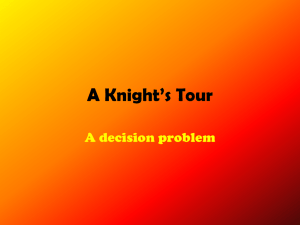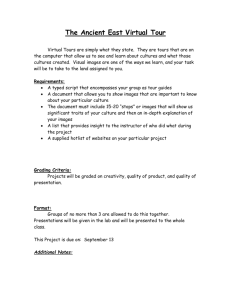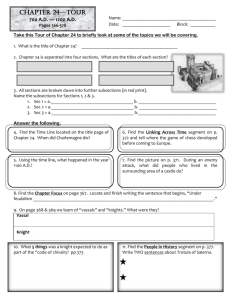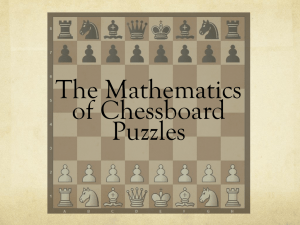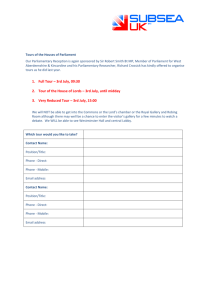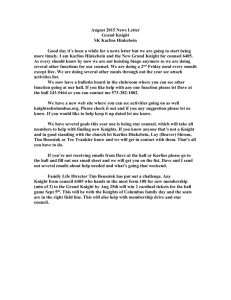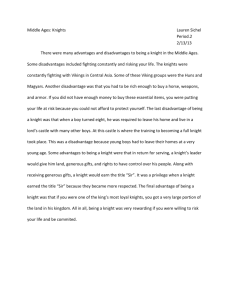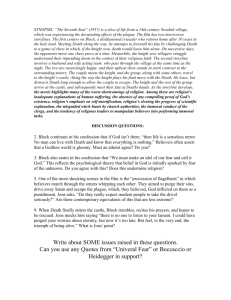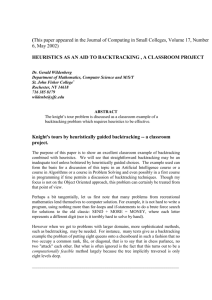Knight`s Tour - work `n` shit
advertisement
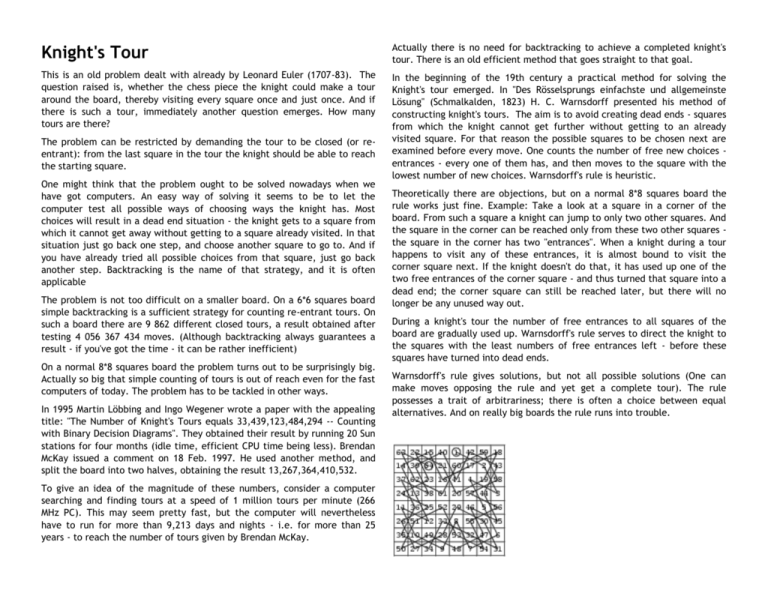
Knight's Tour Actually there is no need for backtracking to achieve a completed knight's tour. There is an old efficient method that goes straight to that goal. This is an old problem dealt with already by Leonard Euler (1707-83). The question raised is, whether the chess piece the knight could make a tour around the board, thereby visiting every square once and just once. And if there is such a tour, immediately another question emerges. How many tours are there? In the beginning of the 19th century a practical method for solving the Knight's tour emerged. In "Des Rösselsprungs einfachste und allgemeinste Lösung" (Schmalkalden, 1823) H. C. Warnsdorff presented his method of constructing knight's tours. The aim is to avoid creating dead ends - squares from which the knight cannot get further without getting to an already visited square. For that reason the possible squares to be chosen next are examined before every move. One counts the number of free new choices entrances - every one of them has, and then moves to the square with the lowest number of new choices. Warnsdorff's rule is heuristic. The problem can be restricted by demanding the tour to be closed (or reentrant): from the last square in the tour the knight should be able to reach the starting square. One might think that the problem ought to be solved nowadays when we have got computers. An easy way of solving it seems to be to let the computer test all possible ways of choosing ways the knight has. Most choices will result in a dead end situation - the knight gets to a square from which it cannot get away without getting to a square already visited. In that situation just go back one step, and choose another square to go to. And if you have already tried all possible choices from that square, just go back another step. Backtracking is the name of that strategy, and it is often applicable The problem is not too difficult on a smaller board. On a 6*6 squares board simple backtracking is a sufficient strategy for counting re-entrant tours. On such a board there are 9 862 different closed tours, a result obtained after testing 4 056 367 434 moves. (Although backtracking always guarantees a result - if you've got the time - it can be rather inefficient) On a normal 8*8 squares board the problem turns out to be surprisingly big. Actually so big that simple counting of tours is out of reach even for the fast computers of today. The problem has to be tackled in other ways. In 1995 Martin Löbbing and Ingo Wegener wrote a paper with the appealing title: "The Number of Knight's Tours equals 33,439,123,484,294 -- Counting with Binary Decision Diagrams". They obtained their result by running 20 Sun stations for four months (idle time, efficient CPU time being less). Brendan McKay issued a comment on 18 Feb. 1997. He used another method, and split the board into two halves, obtaining the result 13,267,364,410,532. To give an idea of the magnitude of these numbers, consider a computer searching and finding tours at a speed of 1 million tours per minute (266 MHz PC). This may seem pretty fast, but the computer will nevertheless have to run for more than 9,213 days and nights - i.e. for more than 25 years - to reach the number of tours given by Brendan McKay. Theoretically there are objections, but on a normal 8*8 squares board the rule works just fine. Example: Take a look at a square in a corner of the board. From such a square a knight can jump to only two other squares. And the square in the corner can be reached only from these two other squares the square in the corner has two "entrances". When a knight during a tour happens to visit any of these entrances, it is almost bound to visit the corner square next. If the knight doesn't do that, it has used up one of the two free entrances of the corner square - and thus turned that square into a dead end; the corner square can still be reached later, but there will no longer be any unused way out. During a knight's tour the number of free entrances to all squares of the board are gradually used up. Warnsdorff's rule serves to direct the knight to the squares with the least numbers of free entrances left - before these squares have turned into dead ends. Warnsdorff's rule gives solutions, but not all possible solutions (One can make moves opposing the rule and yet get a complete tour). The rule possesses a trait of arbitrariness; there is often a choice between equal alternatives. And on really big boards the rule runs into trouble. Find words corresponding to the definitions: Give the English for: (some of them are in the text) Intended to increase the probability of solving some problem by using common sense Case Echecs Echec et mat Echiquier Pat Plateau Rangée Roquer To break apart To set about dealing with The state of acting more from caprice than from reason or judgment By that means or because of that Find the English for: Write the questions corresponding to the underlined elements in the following sentences taken from the text: Impasse Pas Certain, sûr Assez, relativement Efficace This is an old problem dealt with already by Leonard Euler. Find the opposites: The problem turns out to be surprisingly big. Immediately Repulsive Confront In the beginning of the 19th century a practical method for solving the Knight's tour emerged. Complete the table: English r p k n q b Français Warnsdorff's rule is heuristic. From such a square a knight can jump to only two other squares. Phrasal verbs: Find the phrasal verbs corresponding to the following definitions using GET or TURN as the stem, and one of the following prepositions : What do these commonly used abbreviations mean? ALONG, AWAY, BACK, DOWN, IN, INTO, OFF, ON, OUT OF, OVER, UP Arise from bed, a chair etc. Decrease volume OR refuse enter a bus or train etc. OR have a good relationship with enter a car escape Extinguish a light OR appear, happen have a good relationship with Increase volume or intensity Leave a bus or train etc. leave a car OR avoid some unpleasant activity Latin Meaning A.M. c. or ca cf. e.g. et al. etc. i.e. N.B. op. cit. P.M. P.S. Q.E.D. v., vs. viz. Observe the uses of ‘so’ and ‘such’ in the text. Can you determine a rule? Complete and translate: recover from an illness or a bad experience My processor is _____________ hot today. I hope the fan hasn’t stopped working. return from somewhere OR retrieve Reverse Start a machine, equipment, light etc. OR arouse sexual interest Stop a machine, equipment, light etc. submit classwork OR go to bed transform He’s written ____________ a useful program to calculate moon phases. Windows crashes ____________ frequently that I’m thinking of switching to Linux. Nowadays many people use instant messaging, but recent events have shown that _______________ programs are vulnerable to Trojan horse viruses. I’ve installed __________ many different browsers on my computer that I don’t know which one to use.
